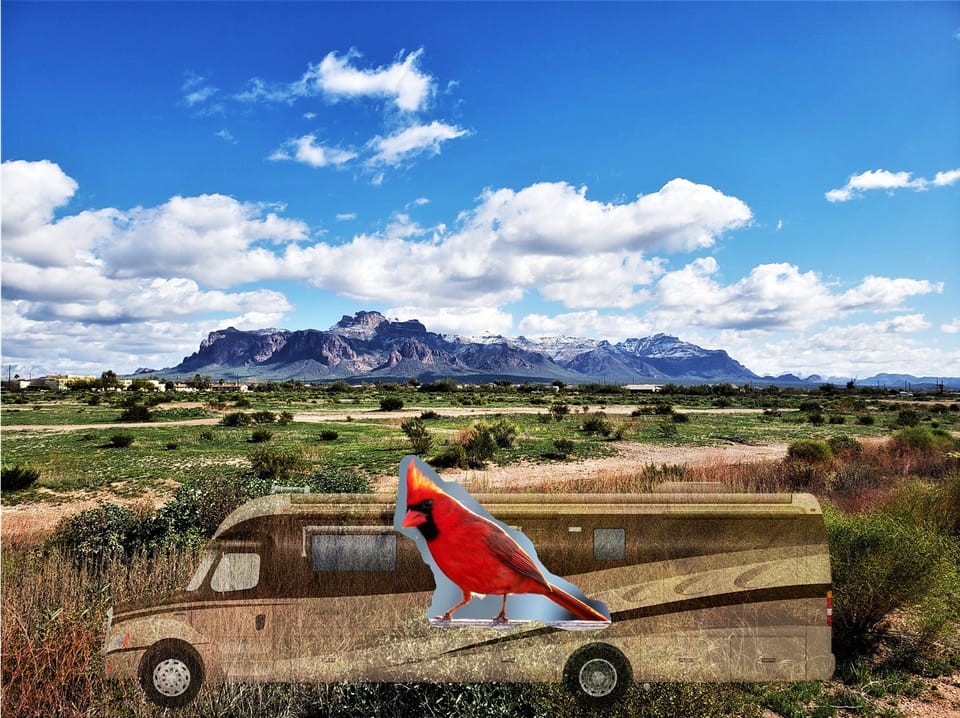A Cardinal in the Superstitions: Reflections on Nature and History

I had never before seen the crested head of the Cardinal in its glory—at least, not in person. Though familiar with the red birds, as most are by way of photos, I had yet to see them darting through morning air or perching in trees, distinguished by their regal bearing. These birds—specifically, the males of the species—contrast the earthtones of desert life, the rock formations and cacti that cover the land, and, in glorious fashion, accent the Arizona sky with their brightness—which is where our story begins.
Although the geologic features and plants here are rich in texture, they grant us a monotony of green and brown. Even when one proceeds into the Painted Desert, colors still blend with grace, rarely emphasizing one region over another. And this is where Cardinals of the Southwest best exhibit their beauty, in my estimation, adding bright color to an otherwise muted palette. I saw one for the first time in the Superstition Mountains.
Arriving from California, and the coastal chaparral of San Diego, I was comfortable with dull landscapes. The ocean was never far, with its raging glories and the sunsets I cherished for their drama. The native vegetation was mainly brown/gray, however, apart from gardens and cultivated spaces, as well as the beauty of the Anza-Borrego Desert in full-bloom. I look back on my former home with fondness and happily recall my years spent working in this environment. During that wonderful season of life, I was able to learn a great deal about local plants and animals, many of which I recall to this day.
As a park ranger in San Diego, I enjoyed the annual appearance of white pelicans as they migrated for the winter, mingling with the aquatic birds that remained year-round. Then, in 2023, the changing dimensions of life brought me to Southern Arizona. And with that, I found a new appreciation for the Lord’s unfathomable power and nature’s beauty. The giant aquatic birds have been replaced in my experience by the diminutive and bright Cardinals. And the lessons they convey are compelling.
Indeed, the sameness of our lives can give way as we explore nature. Meetings and electronic interruptions fade before its myriad forms, mountains graced with plants and animals beyond number, vast oceans, and the ongoing illuminations of sun. Upon arrival, I was struck by the dramatic vistas of Arizona, jagged mountains and buttes extending into the distance. I imagined travelers of ages past marveling at the landscape, admiring the environment that would, in many cases, kill them. A sense of hopeless wonder prevails here. If things go wrong, even in the slightest, the end can come with brutal force, no reprieve for the unprepared or the unlucky. Nothing brings this to mind like the Superstition Mountains, a land sacred to the Apache Nation.
Coffee Break Reflections . . .
As one enters the landscape, a sense of distance and thoughts of the otherworldly become palpable, easily giving rise to imaginative speculation. During a coffee break, I entertain creative digressions, transforming colors of the natural realm into the pastel shades of a dream. Then, I return to the moment newly refreshed.

Up the perilous highway of the Tonto National Forest, I drove my class C motorhome one winter. My cat and I were headed for the campground at Tortilla Flats, so named for an event of the 1940s. By the grace of God, stranded workers had survived a terrible flood by baking tortillas, subsisting until the waters receded. Upon visiting the museum and giftshop in the small town, visitors discover numerous photos of Apache warriors and stories of the fabled flood. And lunchtime brings the flavor of outdoor barbeque accompanied by country music, a great draw for throngs of motorcyclists and tour groups. It is a place of sensory overload. Nestled at elevation, deep in the forbidding shadows of the Superstitions, the area is carved out of the mountains. And the floods are terrifying, as a road to the north made quite clear, having filled with snowmelt earlier in the week. Then, one morning, the less welcoming elements subsided, and a Cardinal perched in my campsite.
From the Audubon Society, we learn that these birds are abundant, being emblems for a number of eastern states and familiar to most people. The Northern Cardinal (Cardinalis cardinalis) thrives in diverse habitats, from deserts and woodlands to urban parks and gardens in the suburbs, requiring only dense bushes for their nests and sufficient foraging. Insects and ground vegetation provide their diet. Fed by both parents, nestlings make their way into the world in roughly 11 days, and we find their species thriving from New York down through the lush regions of Mexico. And, of course, they enliven the Southwestern desert with their magnificent color and songs of courtship.
Still in awe of the sheer cliffs and forbidding heights, as my trip continued, Cardinals came to mind as I regarded the mountains and their cool shadows. How strange it was to find elegant shades of red darting through the Superstitions, taunting frail humans, creatures who succumb to the environment like wilting flowers. By contrast, these little birds have no trouble. I consider this as I heat remnants of morning coffee in the shadows of winter.
My trip ends far too soon.
Sunlight of the season rises above the campground, and the perched Cardinal departs as suddenly as it arrived. With that, I pack my gear into the waiting motorhome and head for the highway.